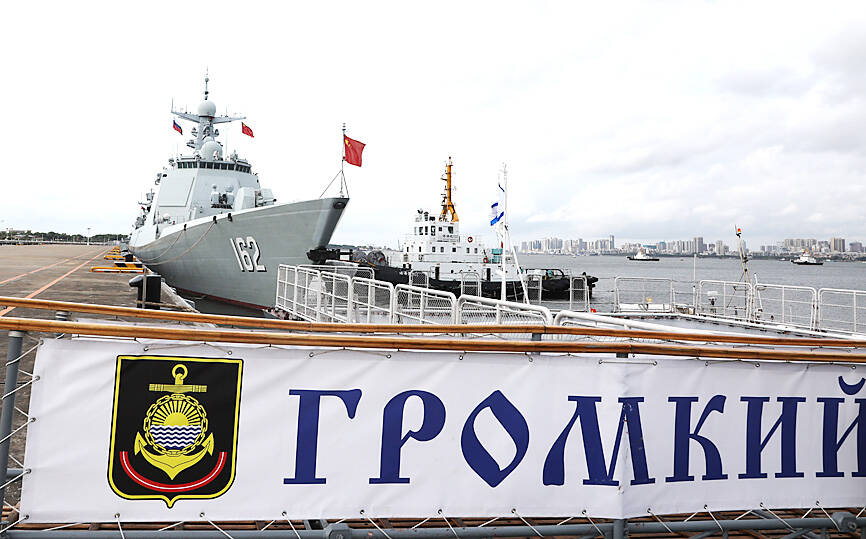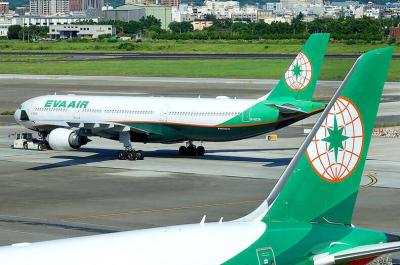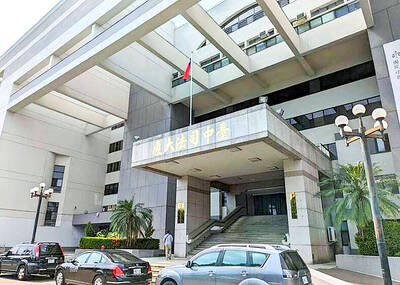The solidifying military alliance between China and Russia constitutes a grave challenge to regional security, the Mainland Affairs Council (MAC) said in a report released yesterday.
The increase in Sino-Russian strategic cooperation has triggered a regional arms race, making the region less secure and stable, said the MAC-commissioned report, which was edited by Tung Hui-ming (董慧明), an associate professor of China military studies at National Defense University.
Naval drills jointly conducted by China and Russia in July were a sign that the two nations intended to further their military cooperation, which could lead to a surge in low-intensity “gray zone” conflict, the report said.

Photo: EPA-EFE / Xinhua / Liu Fang
In May, Russian President Vladimir Putin met with Chinese President Xi Jinping (習近平) in Beijing, saying in a joint statement that the two nations would deepen their comprehensive strategic partnership, it said.
The statement declared an intention to upgrade collaboration between Beijing and Moscow in political, economic and military domains while putting their discontent with the Western-led international order on display, the report said.
The Chinese and Russian combined naval drills from July 15 to 17 were a demonstration of their joint military capabilities and show of force directed at nations in the region, it said.
The exercises were conducted in waters off Zhanjiang in China’s Guangdong Province, the base of operations for the Southern Theater Command of the Chinese People’s Liberation Army Navy (PLAN), the report said.
The selection of the naval base in Zhanjiang to assemble the fleets that took part in the drills signaled the intent and apparent capability of Beijing and Moscow to project power jointly in the region, it said.
The PLAN deployed the Nanning Type 052D guided missile destroyer, two Type 054A guided missile destroyers and a Type 903 replenishment oiler, as well as navy helicopters and marines, while Russia deployed two Gnevny-class destroyers and a Dubna-class oiler, the report said.
The combined force possessed potent anti-ship, anti-submarine and logistics capabilities, and implied that the two navies have achieved interoperability, it said.
Their bolstered military cooperation is likely to facilitate the expansion of China’s sphere of influence, increase Chinese military activities in the Pacific — including in the Taiwan Strait — and lead to a hardening of the US-led security alliance in the region, it said.
As East Asian nations perceive military displays by China and Russia as a direct challenge to their sovereignty and territorial integrity, and not merely for show, their responses would likely be forceful, the report said.
That means regional conflicts might escape the “gray zone” to become low-intensity, but high-frequency clashes, it said, adding that more effective deconfliction mechanisms are needed to maintain peace and security in the region.

The first global hotel Keys Selection by the Michelin Guide includes four hotels in Taiwan, Michelin announced yesterday. All four received the “Michelin One Key,” indicating guests are to experience a “very special stay” at any of the locations as the establishments are “a true gem with personality. Service always goes the extra mile, and the hotel provides much more than others in its price range.” Of the four hotels, three are located in Taipei and one in Taichung. In Taipei, the One Key accolades were awarded to the Capella Taipei, Kimpton Da An Taipei and Mandarin Oriental Taipei. Capella Taipei was described by

EVA Airways today confirmed the death of a flight attendant on Saturday upon their return to Taiwan and said an internal investigation has been launched, as criticism mounted over a social media post accusing the airline of failing to offer sufficient employee protections. According to the post, the flight attendant complained of feeling sick on board a flight, but was unable to take sick leave or access medical care. The crew member allegedly did not receive assistance from the chief purser, who failed to heed their requests for medical attention or call an ambulance once the flight landed, the post said. As sick

The Taichung District Court yesterday confirmed its final ruling that the marriage between teenage heir Lai (賴) and a man surnamed Hsia (夏) was legally invalid, preventing Hsia from inheriting Lai’s NT$500 million (US$16.37 million) estate. The court confirmed that Hsia chose not to appeal the civil judgement after the court handed down its ruling in June, making the decision final. In the June ruling, the court said that Lai, 18, and Hsia, 26, showed “no mutual admiration before the marriage” and that their interactions were “distant and unfamiliar.” The judge concluded that the couple lacked the “true intention of

A drunk woman was sexually assaulted inside a crowded concourse of Taipei Railway Station on Thursday last week before a foreign tourist notified police, leading to calls for better education on bystander intervention and review of security infrastructure. The man, surnamed Chiu (邱), was taken into custody on charges of sexual assault, taking advantage of the woman’s condition and public indecency. Police discovered that Chiu was a fugitive with prior convictions for vehicle theft. He has been taken into custody and is to complete his unserved six-month sentence, police said. On Thursday last week, Chiu was seen wearing a white